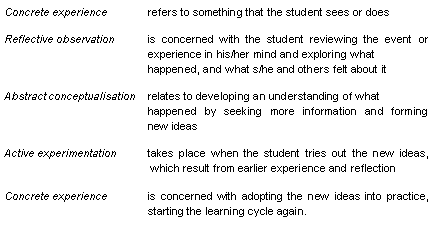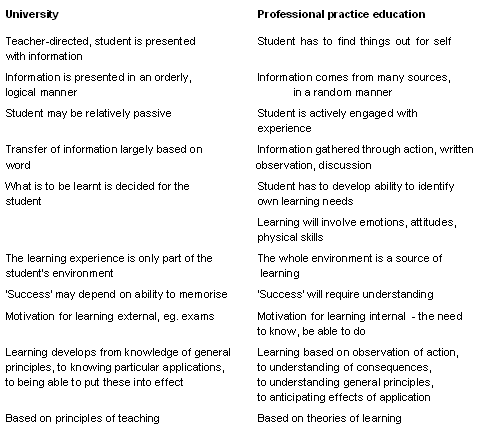Approaches to teaching and learning
In this section we look briefly at a number of approaches to teaching and learning which are relevant to professional practice education, and clarify some of the terms you might come across. Later in the section, we help you think about your own learning preferences and how these might affect your approach to educating students.
As you are aware, programmes leading to professional qualifications differ in the way they are organised. They will also differ in the way that they deliver the curriculum, using new methods of teaching, and perhaps incorporating problem-based learning, Baden and Major (2004). Nevertheless, most programmes still retain some traditional elements, such as lectures. Students embarking on practice placements may find that the way they learn in the workplace will be very different from much of their learning at university - for example, in the way information is presented to them, and in the way they may need to seek out information for themselves.
 Think back to when you were a student.
Think back to when you were a student.
Write down 3 features of a good and the 3 features of a poor placement experience that you had.
How did these experiences affect your learning experience?
Experiential learning
In most cases, the learning that students will engage in during practice education can be described as experiential learning - learning from experience. They will have less need for memorising and reproducing facts (a surface approach to learning) than for developing understanding, and being able to relate new experience to existing knowledge (a deep approach). Vital to this is the notion of reflection. Because much of what students encounter in the service environment will be new to them, they must be able to make sense of what they see and do - through reflection - in order that 'experience' becomes 'learning', Jasper (2003).
Definition of types of reflection may be useful as in clinical practice you use many different types of reflection and these are not necessarily most useful for a student.
Many writers have explored this area, including Kolb (1984). He represents the process of experiential learning as a learning cycle, as in the diagram below.

In terms of practice education:

Students need time to engage in the process of reflection, and can be encouraged to do so through discussion (before, during and after an event) with their practice educator, Bolton (2001).
Reflective learning plays an important part in the development of professional practitioners, as has been shown in the research of Schön (1983), and is involved in the development of clinical reasoning.
Clinical reasoning concerns thinking, or talking, about the way you work, and giving the reasons for what you do. It forms the basis of the therapeutic process and underpins problem solving. It involves:
- The acquisition of a knowledge base
- The development of a breadth of ideas to help in problem-solving
- The identification of probable solutions
- Informed action.
Clinical reasoning is complex, and does not follow a straightforward, linear procedural path. It cannot be taught, as it is embedded in practice and develops as the understanding of clinical problems grows. It is usually an internal process, hidden to others, as therapists are unused to talking through what they are doing. However, you can help students understand what is involved if you are able to explain how you have come to make specific decisions, or to take a particular course of action. Schön has shown how students can be 'coached' in a safe environment, by repeating a task and stopping at intervals to explain an action or point out important factors, or by stopping during a task and asking the student to decide on the next action to take, Higgs and Jones (1999), Ryan and McKay (1999).
Independent or self-directed learning
Experiential learning, in which reflection plays such an important part, is closely linked with ideas about the way adults learn. Knowles (1979) and Boud (1988) are influential writers in this area. Knowles has shown that adults:
- Aspire to be, and usually become, more independent as they mature
- Have a rich resource for learning in their own experiences, and learn more effectively through experiential means
- Are aware of the specific learning needs generated by real-life tasks and problems
- Like to apply their newly acquired skills and knowledge to their immediate circumstances.
Students can be encouraged to become more independent, and to take more responsibility for their own learning - for example, through identifying their own learning needs for a particular placement. The role of the practice educator, therefore, is to facilitate learning, rather than to take charge of it.
There are other terms you may come across, and which might be useful in thinking about practice education. These include:
Autonomy A state of having responsibility for decision-making and of being independent in learning; practice educators can assist students in working towards this goal.
Contract learning The use of a negotiated document drawn up by the student and his/her practice educator; the contract specifies what the student will learn, how this will be accomplished, within what period of time, and what the criteria for evaluation will be.
Problem-based learning Students, usually in small groups, are presented with clinical scenario; with the guidance of a facilitator they have to define the problem(s) involved and identify and seek out the information they need in order to understand and identify possible solution pathways.
Spiral learning A process in which educational concepts, knowledge and skills are presented in a recurrent manner, so that proficiency and integration are progressively fostered and tested in the development of understanding and practical competence; aids the development of clinical reasoning.
 Divide a sheet of paper into two and label one half "University" and the other half "Practice education".
Divide a sheet of paper into two and label one half "University" and the other half "Practice education".
What are the main features of teaching & learning in each of these contexts?
Compare your thoughts with those suggested in our answer.
 Watch the video clips.
Watch the video clips.
http://www.liv.ac.uk/healthsciences/pg_movies/OT_1.wmv
http://www.liv.ac.uk/healthsciences/pg_movies/OT_3.wmv
What are the positive and negative features of the teaching & learning experience in this video clip?
Your role, as a practice educator, is going to be crucial in helping a student to learn and to develop autonomy. It is important to know your learning style as this will influence your preferred teaching methods, which may not be appropriate for all students. A variety of teaching methods should be adopted to facilitate student learning in practice, O'Sullivan (2002).
Students with particular learning needs should discuss their individual requirements with the practice educator.
 To identify your preferred learning style you could complete the learning style questionnaires on the following websites:
To identify your preferred learning style you could complete the learning style questionnaires on the following websites:
Whatever your preferences, it is what you do as a practice educator that is important. Research suggests that it is the facilitator of learning (in this case, you, as practice educator) who has much to do with setting the climate of the learning environment (your particular service setting).
What expectations there will be of you, and what you might expect of professional practice students and their university, is the focus of the next section.
Approaches to teaching and learning
The way in which teaching and learning occurs will not fall neatly into one or other of these two categories; there will be an overlap between them. However, these might be some of the characteristics you would observe when comparing a 'traditional' university course and practice education.
